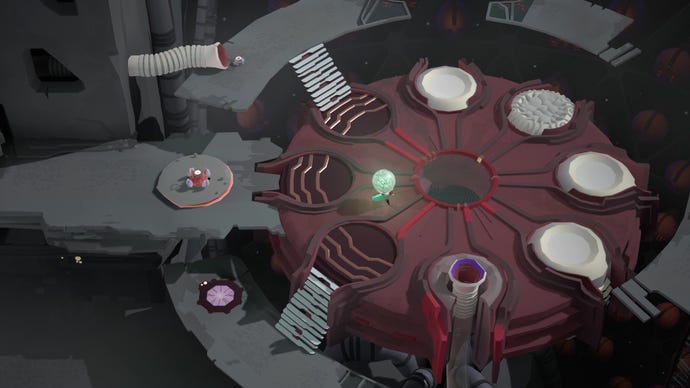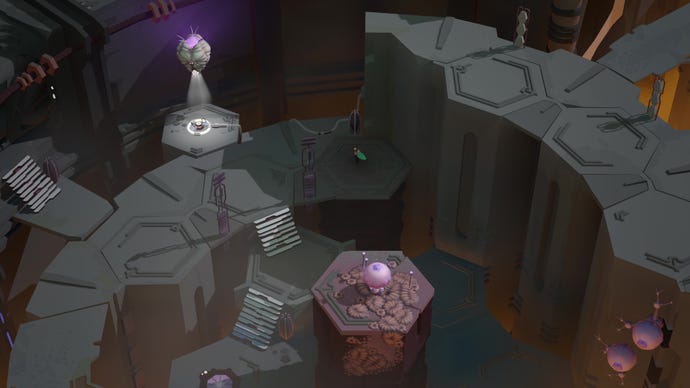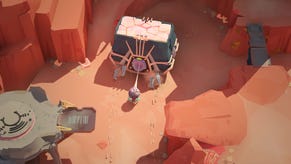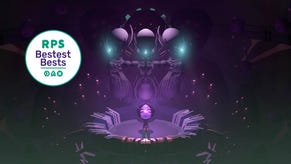Cocoon's greatest mysteries are hidden behind puzzles most players won't find
Game director Jeppe Carlsen and art director Erwin Kho on their puzzle game's secret ending
It’s been a good handful of years for fans of secret-ridden games. The sort of secrets that make the game world feel huge and unknowable and transform the post-game into a scavenger hunt more akin to ARGs than classic secret endings. After 2021’s meta deckbuilder Inscryption, and enigmatic Zeldalike Tunic a year later, 2023 brought us Cocoon. Set in a cryptic world of insect-like aliens and their impossible machines, Cocoon is a puzzle game all about mystery.
What best sells the mystery is a minority of puzzles that are so well-hidden, that a lot players might never know they exist. Those are the optional challenges that guard the way to Cocoon's secret ending. Any given player might stumble on one or two clues for those puzzles, before shrugging and finding their way back to the main story. But as the game goes on and the clues remain unresolved, those players will wonder what other secrets are hidden around them. I talked to Jeppe Carlsen and Edwin Kho from developer Geometric Interactive, to learn why those puzzles were made, and how it feels to watch a community track them down in real time.
Cocoon’s world feels viscerally alien from the word go. Two tricks help achieve this. The first is Cocoon’s signature game loop where, like any classic adventure game protagonist, our little moth-like alien spends most of his time carrying items around to activate mechanisms - but, in this case, the little spheres used to interact with the environment are also contain new worlds that you can jump into.
Solving a puzzle in the main world might mean diving into multiple, nesting spheres, which often interact with one another in unexpected ways. If it sounds confusing, that’s because it is. It’s unlike anything from this Earth, which is why it feels so alien. But Geometric Interactive had another trick to add mystery to this story. It’s much more straightforward than the infinite reality loop, and based entirely around the game's use of dialogue. Put simply, it doesn’t have any. It has no text at all.
“I think not even having text or symbols as tutorial prompts helps give the game a mysterious quality,” Carlsen, Cocoon's game designer and director, tells me in an interview. “You can get immersed immediately and you can almost forget that the game is in fact made by people.”
It isn’t the first time Carlsen has used this trick. Limbo and Inside, games for which he was the lead gameplay designer, are silent, too. But even if he’s used to it by now, explaining the rules of a puzzle in Cocoon, without using any words, still requires ingenious solutions. “Every time you beat a boss and unlock a new ability, you always get locked into a small environment until you have figured out how to interact with this new ability,” Carlsen explains.
So why abandon words if they make things so much simpler? As art director Kho explains, it’s more fun. “There’s a fun design challenge inherent to only using visuals to convey a backstory," he says. "We think that spelling things out literally would take away the opportunity for the player to imagine stories for themselves.”


As Cocoon comes to an end, you're greeted by a lengthy final cinematic, which is as confusing as anything that came before. The camera flies all the way back into outer space, revealing that the spheres have morphed into planets, as our protagonist mutates into an ominous, gigantic form, its eyes glowing behind the solar system we helped him create.
The game might have ended, but the mystery doesn’t, and the world becomes no less alien, leaving players without answers or explanations. It certainly creates a lot of suspense, though - enough to set many players on the path to the secret ending. A secret ending that reveals almost no new information, mind you, but that’s fine. The strength of this optional second playthrough is the journey, not the destination, and that goes for the players that don’t finish the secret ending, too. “Even though most players don’t solve any of these [optional] secrets, they still might stumble upon some of the hints, and get this nice feeling that something seems to be hidden in this game,” Carlsen explains.
Secret endings are going through some kind of golden age. Now, I realise that might sound like an exaggeration; games have always had hidden content, and it’s not like the practice ever went away. But the quest to find those secrets has never been as commonly convoluted as it is now. The Inscryption ARG lasted for months. Tunic featured two distinct and optional secret languages, one hidden entirely in its soundtrack. Even an alternate ending as tame as Signalis’s involved an obscure image-to-video encryption method called SSTV.
But is this a movement? Is there anything special binding those secret endings together? Or do we just now have the online communities necessary to turn puzzle-solving into a group activity? Carlsen seems to tend towards the second option: “Our goal was to design something simple that could be solved by a dedicated individual player, but would still be fun for a small group working together online.”

But while the optional puzzles in Cocoon aren’t as elaborate as a full-blown ARG, as the devs note, calling them “simple” might be an understatement. As a matter of fact, the team might have underestimated how difficult those puzzles can get. The final ending was found about a week after release - not too long, but still longer than Carlsen exepcted. “Honestly, I thought the secret ending would be found even faster due to the consistent logic of the secret puzzles,” he says.
The final puzzles definitely have a consistent core: they’re all five-digit codes, and they are all found in vaguely similar situations. But beyond that, this final section of the game is incredibly varied. This isn’t a single, hard final puzzle. It’s a multi-stage process that starts by learning what to look for, with no particular clue that stands out. And even in the later stages, once the real secret hunt begins, some puzzles require different skills besides patience and a keen eye. The worst offender expects a keen ear instead.
“Honestly, I thought the secret ending would be found even faster.”
Cocoon’s secret music puzzle could have been a simple test of writing down a melody and playing it back later. This is already a big ask for non-musical players, but Cocoon manages to make it even harder. The melody isn’t clearly labelled, and every sound is muffled by the surrounding soundscape. And if that wasn’t enough, the sound itself is harsh and metallic, not very melodious at all. This challenge, while a nice surprise for the musically trained minority, is the doom of all other puzzle solvers.
The developers knew that directing players without words would be difficult; Carlsen notes that having no dialogue “means that you as a designer never have an 'easy way out' - the level design needs to always teach you exactly what you need to learn to progress.” This self-imposed silence made Cocoon more interesting, but it made its toughest puzzles even less forgiving. Or at least that’s the case for solo players.
So the music puzzle might be impossible for one unlucky person, but not for a community. It only takes one player to spot the weird sound, maybe another to figure out the melody. In the meantime, everyone else can find where to input the solution or work on other puzzles. That’s the thing about communities and puzzles. The deeper you hide a secret, the harder it is to solve, but the more satisfying the solution becomes. Getting more people to look for the solution can help level those tough patches without making the solution less fulfilling.
Right after the release of Cocoon, a small group of puzzle hunters got together on Discord and the Steam Forums. They found the secret ending after only a week of research, but their work didn’t end there. A curious and patient player can still approach Geometric Interactive’s hardest puzzles alone, but their trek towards the final ending is made infinitely more approachable by the trail left by those who went there before.

That Steam Forums thread is interesting reading for those trying to solve the secret puzzles, but if you don’t want to read through what sometimes sounds like the ravings of conspiracy theorists, the community also prepared a thorough guide that helps lone players solve the puzzles by themselves.
But as it turns out, the secret hunters' thread isn’t just for the players. Kho seemed particularly interested in reading about the players’ progress. “They seemed so engaged with solving the secret puzzle it was hard not to quietly follow their progress and to read their thoughts,” he tells me. Thinking about it, it makes sense that a community thread like this would have a special meaning to a developer. “It was very satisfying to watch people figure out the trail of hints we had laid out,” he says, “but also interesting seeing them get side-tracked by elements in the game that had nothing to do with the secret, and to read their reasoning about them.”
A good secret hunt can spice up pretty much any game, as was the case with Inside. But, unlike similar games that came before it, Cocoon’s cryptic world isn’t one big puzzle to be solved by the end. If Limbo had dialogue, the words would betray its iconic twist; Cocoon, meanwhile, doesn’t have a twist to spoil. No plot element remains shrouded in mystery, until the last cutscene fills in the details of the backstory. Cocoon's mystery remains unresolved even after the game’s second ending.
And I think a game like Cocoon all but needs the promise of another secret hiding just out of sight. Players need that promise to understand that somewhere, in this unknowably large world, in a place hidden even to the game’s own creators, there is an unfound clue that might make this cryptic world utterly knowable; that even if we don’t understand it, this world isn’t meaningless.

















